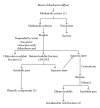Anti-Convulsant Activity of Boerhaavia diffusa: Plausible Role of Calcium Channel Antagonism
- PMID: 19948752
- PMCID: PMC3135233
- DOI: 10.1093/ecam/nep192
Anti-Convulsant Activity of Boerhaavia diffusa: Plausible Role of Calcium Channel Antagonism
Abstract
"Ethnopharmacological" use of roots of Boerhaavia diffusa (B. diffusa) in the treatment of epilepsy in Nigerian folk medicine and reports showing the presence of a calcium channel antagonistic compound "liriodendrin" in its roots, led us to undertake the present study. The study was designed to investigate the methanolic root extract of B. diffusa and its different fractions including liriodendrin-rich fraction for exploring the possible role of liriodendrin in its anti-convulsant activity. Air-dried roots of B. diffusa were extracted with methanol by cold maceration. The methanol soluble fraction of extract thus obtained was successively extracted to obtain liriodendrin-rich fraction and two side fractions, that is, chloroform fraction and phenolic compound fraction. Anti-convulsant activity of methanolic extract (1000, 1500 and 2000 mg kg(-1), intraperitoneally (i.p.)) and its different fractions, that is, liriodendrin-rich fraction (10, 20 and 40 mg kg(-1), i.p., chloroform fraction (20 mg kg(-1), i.p.) and phenolic compound fraction (1 mg kg(-1), i.p.) were studied in pentylenetetrazol (PTZ)-induced seizures (75 mg kg(-1), i.p.). The crude methanolic extract of B. diffusa and only its liriodendrin-rich fraction showed a dose-dependent protection against PTZ-induced convulsions. The liriodendrin-rich fraction also showed significant protection against seizures induced by BAY k-8644. These findings reiterated the anti-convulsant activity of methanolic extract of B. diffusa roots. Furthermore, it can be concluded that the observed anti-convulsant activity was due to its calcium channel antagonistic action as this activity was retained only in the liodendrin-rich fraction, which has additionally been confirmed by significant anti-convulsant activity of liriodendrin-rich fraction in BAY k-8644-induced seizures.
Figures




Similar articles
-
Constituents of the roots of Boerhaavia diffusa L. III. Identification of Ca2+ channel antagonistic compound from the methanol extract.Chem Pharm Bull (Tokyo). 1991 Jun;39(6):1551-5. doi: 10.1248/cpb.39.1551. Chem Pharm Bull (Tokyo). 1991. PMID: 1934177
-
Biochemical and molecular anticancer approaches for Boerhaavia diffusa root extracts in oral cancer.J Cancer Res Ther. 2022 Dec;18(Supplement):S244-S252. doi: 10.4103/jcrt.JCRT_932_20. J Cancer Res Ther. 2022. PMID: 36510972
-
Inhibition of Human Cervical Cancer Cell Growth by Ethanolic Extract of Boerhaavia diffusa Linn. (Punarnava) Root.Evid Based Complement Alternat Med. 2011;2011:427031. doi: 10.1093/ecam/nep223. Epub 2011 May 2. Evid Based Complement Alternat Med. 2011. PMID: 21869896 Free PMC article.
-
Ethnomedicinal values of Boerhaavia diffusa L. as a panacea against multiple human ailments: a state of art review.Front Chem. 2023 Nov 14;11:1297300. doi: 10.3389/fchem.2023.1297300. eCollection 2023. Front Chem. 2023. PMID: 38033469 Free PMC article. Review.
-
In vitro and in vivo anti-seizure activity of hydromethanolic extract and fractions of Pterolobium stellatum.J Ethnopharmacol. 2023 Mar 25;304:116073. doi: 10.1016/j.jep.2022.116073. Epub 2022 Dec 18. J Ethnopharmacol. 2023. PMID: 36543277
Cited by
-
Pharmacological Basis for the Medicinal Use of Lepidium sativum in Airways Disorders.Evid Based Complement Alternat Med. 2012;2012:596524. doi: 10.1155/2012/596524. Epub 2012 Jan 15. Evid Based Complement Alternat Med. 2012. PMID: 22291849 Free PMC article.
-
Identification of novel anti-inflammatory agents from Ayurvedic medicine for prevention of chronic diseases: "reverse pharmacology" and "bedside to bench" approach.Curr Drug Targets. 2011 Oct;12(11):1595-653. doi: 10.2174/138945011798109464. Curr Drug Targets. 2011. PMID: 21561421 Free PMC article.
-
Phytochemical, therapeutic, and ethnopharmacological overview for a traditionally important herb: Boerhavia diffusa Linn.Biomed Res Int. 2014;2014:808302. doi: 10.1155/2014/808302. Epub 2014 May 14. Biomed Res Int. 2014. PMID: 24949473 Free PMC article. Review.
-
Insights about multi-targeting and synergistic neuromodulators in Ayurvedic herbs against epilepsy: integrated computational studies on drug-target and protein-protein interaction networks.Sci Rep. 2019 Jul 22;9(1):10565. doi: 10.1038/s41598-019-46715-6. Sci Rep. 2019. PMID: 31332210 Free PMC article.
-
Awareness and current knowledge of epilepsy.Metab Brain Dis. 2020 Jan;35(1):45-63. doi: 10.1007/s11011-019-00494-1. Epub 2019 Oct 11. Metab Brain Dis. 2020. PMID: 31605258 Review.
References
-
- Dhar ML, Dhar MM, Dhawan BN, Mehrotra BN, Ray C. Screening of Indian plants for biological activity: part I. Indian Journal of Experimental Biology. 1968;6:232–247. - PubMed
-
- Kirtikar KR, Basu BD. Indian Medicinal Plants. 2nd edition. III. Allahabad, India: Lalit Mohan Basu; 1956.
-
- Akah PA, Nwambie AI. Nigerian plants with anti-convulsant property. Fitoterapia. 1993;64(1):42–44.
-
- Gaitonde BB, Kulkarni HJ, Nabar SD. Diuretic activity of punarnava (Boerhaavia diffusa) Bull Haffkine Institute. 1974;2:p. 24.
LinkOut - more resources
Full Text Sources

